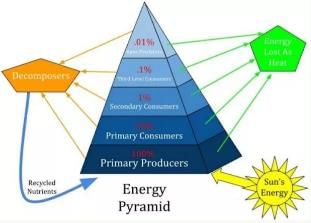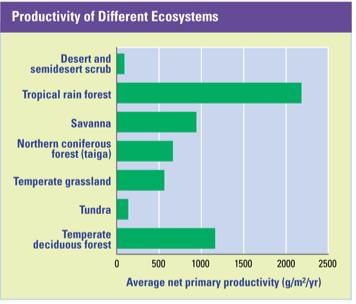Test: Environment- 8 - UPSC MCQ
25 Questions MCQ Test - Test: Environment- 8
Consider the following statements.
- The energy pyramid of an ecosystem is always upright and narrows to the top.
- The biomass in the upper trophic levels is generally very high as compared to the lower trophic levels.
Which of the above statements is/are correct?
Arrange the following ecosystems in the decreasing order of biomass productivity (g per metre square per year).
- Coral reefs
- Open ocean
- Tropical rainforest
- Deserts
Select the correct answer code:
Consider the following statements.
- In the aquatic environment, the sediment-characteristics often determine the type of benthic animals that can thrive there.
- Like humans, plants also have mechanisms to maintain internal temperature.
- Very small animals are rarely found in polar regions since thermoregulation is energetically expensive for these animals.
Which of the above statements is/are correct?
Consider the following statements regarding Phosphorus and Phosphorus Cycle.
- Phosphorus cycle is largely atmospheric and easily dissolves in water from air.
- Phosphorus occurs as a mineral in phosphate rocks and enters the Phosphorus cycle from erosion and mining activities.
- Phosphorus is responsible for excessive growth of rooted and free-floating microscopic plants in water bodies.
Which of the above statements is/are correct?
Why do exotic species post a threat to an indigenous ecosystem such as in a Lake or an isolated island in the Andamans?
- Such species compete with the local or native species for food.
- They may be predators of local species.
- Such species may cause diseases in native species.
Select the correct answer code:
Consider the following statements regarding Bioluminescent organisms.
- Bioluminescent organisms are found only in the ocean environments.
- The colour of the light emitted by the organism depends on their chemical properties.
- In some organisms, Bioluminescence acts as defence mechanism, to protect itself from other organisms.
Which of the above statements is/are correct?
Consider the following statements regarding Parasitism.
- Parasitism occurs when two organisms interact, but while one benefits, the other experiences harm.
- Tapeworm attaching itself to the intestine of a cow is an example of Parasitism.
- The parasite always kill the host.
Which of the above statements is/are correct?
Which one of the following is the correct sequence of ecosystems in the order of decreasing productivity?
Increased Snow cover on a water body can lead to
- Sudden spurt in phytoplankton population which are not dependent on photosynthesis
- Improved oxygen exchange and nutrient recycling in the lake
- A condition of winterkill causing large scale death of fishes and organisms
Select the correct answer code:
The coastal ecosystems of mangroves, tidal marshes, and seagrass meadows provide numerous benefits and services along coasts like
- Protection from storms and sea level rise
- Regulation of coastal water quality
- Provision of habitat for commercially important fisheries
- Food security for many coastal communities
- Sequester and store coastal blue carbon from the atmosphere
Select the correct answer code:
Consider the following statements.
- Cold water corals, in general, have greater amount of zooxanthellae than warm water corals and does not build reef-like structures.
- Cold-water corals differ from warm water corals because the former does not contain symbiotic algae for photosynthesis and grow more slowly.
Which of the above statements is/are correct?
Which of the following are recognised as the Ramsar sites in India?
- Harike Lake
- Wular Lake
- Keoladeo National Park
- Chilika Lake
Select the correct answer code:
Consider the following statements regarding Peatlands.
- Peatlands are wetlands where permanently waterlogged conditions prevent the complete decomposition of dead plant material.
- Peatlands are highly space-effective carbon stocks and contain more carbon than the entire forest biomass of the world.
- Peatlands are formed only under tropical climate conditions.
Which of the above statements is/are correct?
Consider the following statements regarding Coral bleaching.
- When corals are stressed by changes in temperature, light or nutrients, they expel the algae living in their tissue, causing them to turn white.
- Increase in zooplankton levels triggers coral bleaching.
- Cold water temperatures also cause coral bleaching.
Which of the above statements is/are correct?
Consider the following statements regarding Wetlands.
- In India, Wetlands are regulated under the Environment(Protection) Rules, 1986.
- Wetlands International is an independent, not-for-profit, global organisation that works to sustain and restore wetlands and their resources for people and biodiversity.
Which of the above statements is/are correct?
In which of the following trophic levels, you are likely to find the highest concentration of an organic toxin that has been found in ocean water and the aquatic animals inhabiting it?
Consider the following statements regarding Vegetative Propagation.
- Plants raised by vegetative propagation can bear flowers and fruits earlier than those produced from seeds.
- Vegetative propagation is not possible from the plants that have lost the capacity to produce seeds.
- Plants produced through vegetative propagation are genetically similar enough to the parent plant.
Which of the above statements is/are correct?
An ecological pyramid is a diagrammatic presentation to describe trophic levels. How does the knowledge of ecological pyramid can help us in conservation of an ecosystem?
- It helps us to identify bio-accumulation.
- It helps us to identify bio-magnification.
- It helps us to recognize an invasive species.
Select the correct answer code:
Birds Following Army Ants is an example for which of the following types of symbiotic relationship between organisms?
Acid rain is mainly a by-product of a variety of human activities that emit the oxides of
Consider the following statements regarding ocean acidification.
- It largely occurs due to the high absorption of nitrogenous based acidic compounds.
- Introduction of sea grasses can reduce the impact of acidification.
Which of the above statements is/are incorrect?
E-waste contain potentially harmful materials such
- Brominated flame retardants
- Phosphors
- Cadmium
- Beryllium
- Lead
Select the correct answer code:
What are the sources that add nitrogen oxides into the atmosphere?
- Bacteria living in soil
- Reaction of Ultraviolet radiation with ozone
- Lightning stroke
Select the correct answer code:
Consider the following statements regarding Persistent Organic Pollutants (POPs).
- Persistent Organic Pollutants (POPs) have the property of long-range environmental transport (LRET).
- As we move up the food chain, concentrations of POPs tend to decrease so that animals at the top of the food chain tend to have the low concentrations of these chemicals.
- Exposure to POPs can lead to cancer and diseases of immune system.
Which of the above statements is/are correct?





















